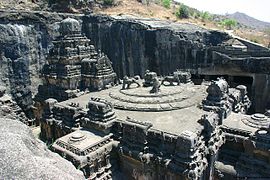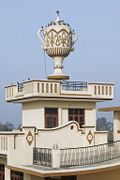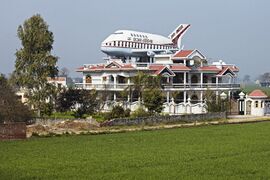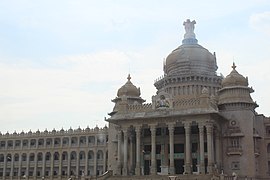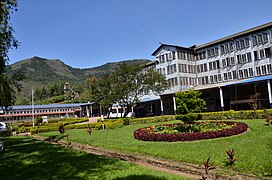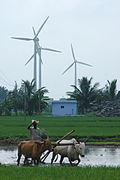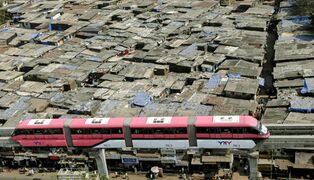Tapakdore: Difference between revisions
mNo edit summary Tag: 2017 source edit |
Tag: 2017 source edit |
||
| (6 intermediate revisions by 2 users not shown) | |||
| Line 22: | Line 22: | ||
|loctext = | |loctext = | ||
|alt_map = <!--alt text for map--> | |alt_map = <!--alt text for map--> | ||
|map_caption = Location of Tapakdore (dark green)<br>In [[Audonia]] (gray) | |map_caption = Location of Tapakdore (dark green)<br>In [[Audonia]] (gray)<br>Eastern Owidura province (lime green) | ||
|map_width = 270px | |map_width = 270px | ||
|image_map2 = | |image_map2 = | ||
| Line 144: | Line 144: | ||
== History == | == History == | ||
===Prehistory=== | ===Prehistory=== | ||
{{Further|Timeline_of_major_world_events#Prehistory}} | {{Further|Timeline_of_major_world_events#Prehistory|label1= Prehistory of the world}} | ||
Battganuur was originally settled by {{wp|Indo-Aryan peoples}} who likewise settled areas from [[Zaclaria]] to [[Pukhgundi]]. These people shared languages with common roots, the {{wp|Indo-Aryan languages}} which later diverged into Proto-Umardonian (west of the [[Sindhus River]]) and proto-Sindhus (east of the [[Sindhus River]]). | Battganuur was originally settled by {{wp|Indo-Aryan peoples}} who likewise settled areas from [[Zaclaria]] to [[Pukhgundi]]. These people shared languages with common roots, the {{wp|Indo-Aryan languages}} which later diverged into Proto-Umardonian (west of the [[Sindhus River]]) and proto-Sindhus (east of the [[Sindhus River]]). | ||
| Line 153: | Line 153: | ||
=== Classical Antiquity === | === Classical Antiquity === | ||
{{Further|Timeline_of_major_world_events#Classical_Antiquity|Arunid Empire}} | {{Further|Timeline_of_major_world_events#Classical_Antiquity||label1= Classical Antiquity|Arunid Empire}} | ||
<gallery mode="packed"> | <gallery mode="packed"> | ||
</gallery> | </gallery> | ||
| Line 163: | Line 163: | ||
===Medieval period and the Sultanate of Ruhunu Pura === | ===Medieval period and the Sultanate of Ruhunu Pura === | ||
{{Further|Timeline_of_major_world_events#Medieval_history|Oduniyyad Caliphate}} | {{Further|Timeline_of_major_world_events#Medieval_history||label1= Medieval history of the world|Oduniyyad Caliphate}} | ||
The Sultanate of Ruhunu Pura traces its origins to the ancient {{wp|Sinhalese|Tapakdi}} kingdom of Ruhuna. With the arrival of Islam through Arab traders, Ruhuna gradually adopted the faith, blending it with existing {{wp|Sinhalese|Tapakdi}} customs and Buddhism. The [[Oduniyyad Caliphate]] recognized Ruhunu Pura's strategic importance for trade in the [[Aab-e-Farus]], establishing it as a sultanate. The Sultan of Ruhunu Pura is the head of state and government, advised by a council of ministers (Diwan) drawn from the nobility and religious scholars. Local administration is handled by regional governors (Disawe) and village headmen (Grama Niladhari). The sultanate follows Islamic law (Sharia) alongside traditional Sinhalese legal customs. Ruhunu Pura is a prosperous trading hub, renowned for its spices (cinnamon, cardamom), gemstones (sapphires, rubies), and textiles (silk, cotton). Its ports are bustling with ships from all across [[Audonia]]. Agriculture also thrived, producing rice, coconuts, and tropical fruits. Both Ruhunu Pura enjoyed considerable autonomy within the [[Oduniyyad Caliphate]], contributing to its cultural and economic diversity, and it benefit from the [[Oduniyyad Caliphate|Caliphate]]'s vast trade networks and military protection, while retaining some of its unique identities and traditions. | The Sultanate of Ruhunu Pura traces its origins to the ancient {{wp|Sinhalese|Tapakdi}} kingdom of Ruhuna. With the arrival of Islam through Arab traders, Ruhuna gradually adopted the faith, blending it with existing {{wp|Sinhalese|Tapakdi}} customs and Buddhism. The [[Oduniyyad Caliphate]] recognized Ruhunu Pura's strategic importance for trade in the [[Aab-e-Farus]], establishing it as a sultanate. The Sultan of Ruhunu Pura is the head of state and government, advised by a council of ministers (Diwan) drawn from the nobility and religious scholars. Local administration is handled by regional governors (Disawe) and village headmen (Grama Niladhari). The sultanate follows Islamic law (Sharia) alongside traditional Sinhalese legal customs. Ruhunu Pura is a prosperous trading hub, renowned for its spices (cinnamon, cardamom), gemstones (sapphires, rubies), and textiles (silk, cotton). Its ports are bustling with ships from all across [[Audonia]]. Agriculture also thrived, producing rice, coconuts, and tropical fruits. Both Ruhunu Pura enjoyed considerable autonomy within the [[Oduniyyad Caliphate]], contributing to its cultural and economic diversity, and it benefit from the [[Oduniyyad Caliphate|Caliphate]]'s vast trade networks and military protection, while retaining some of its unique identities and traditions. | ||
| Line 171: | Line 171: | ||
===Early modern history=== | ===Early modern history=== | ||
{{Further|Timeline_of_major_world_events#Early_modern_history|Burgoignesc colonial empire|Peshabiwar colony}} | {{Further|Timeline_of_major_world_events#Early_modern_history||label1= Early-modern history of the world|Burgoignesc colonial empire|Peshabiwar colony}} | ||
[[File:Bergendii colonies in central Daria.png|right|thumb|Colonies of central Daria.<br> | [[File:Bergendii colonies in central Daria.png|right|thumb|Colonies of central Daria.<br> | ||
*Red- [[Barbary Straits colony]]<br> | *Red- [[Barbary Straits colony]]<br> | ||
| Line 182: | Line 182: | ||
[[Peshabiwar colony]] was a charter colony established by the [[Duchy of Martilles]] in [[1592]], following the Great Confessional War. The colony's initial settlers were Protestant refugees who had been expelled from the Holy Levantine Empire. These devout Calvinists, driven by ambition and a desire to rebuild their lives, sought to establish a new homeland in Tapakdore. Peshabiwar quickly became an economic powerhouse, thanks to its strategic location along the western Silk Road. The colony's fertile land and favorable climate proved ideal for cultivating lucrative cash crops such as sugarcane, pineapples, millet, cotton, and tea. These exports fueled the colony's wealth and attracted further investment from Martilles. However, the colony's prosperity was not solely based on agriculture. Peshabiwar also played a significant role in the slave trade, serving as a major transit point for Ebidi slaves sourced from various colonies in the region. The opening of the Southern Route by the Daxians, diverting trade eastward to Sarpedon, posed a challenge to Peshabiwar's economic dominance. However, the colony's established trade networks and diversified economy allowed it to adapt and maintain its position as a regional economic hub. Over time, Peshabiwar expanded its territory through a combination of military conquest, political maneuvering, and the application of the doctrine of lapse. This doctrine, which allowed Martilles to annex territories where the ruling lineage had died out or was deemed incompetent, facilitated the colony's gradual expansion throughout central Tapakdore. The colonial administration, deeply influenced by Calvinist principles, implemented a strict and efficient system of governance. The colony's laws and institutions reflected the settlers' religious beliefs and their commitment to social order and economic prosperity. By the early 18th century, Peshabiwar had achieved remarkable self-sufficiency. The colony had developed its own distinct political traditions, a thriving economy, a complex social structure, and a well-trained military force. This autonomy and resilience allowed the colony to weather challenges and maintain its status as a vital part of the Martillien empire. | [[Peshabiwar colony]] was a charter colony established by the [[Duchy of Martilles]] in [[1592]], following the Great Confessional War. The colony's initial settlers were Protestant refugees who had been expelled from the Holy Levantine Empire. These devout Calvinists, driven by ambition and a desire to rebuild their lives, sought to establish a new homeland in Tapakdore. Peshabiwar quickly became an economic powerhouse, thanks to its strategic location along the western Silk Road. The colony's fertile land and favorable climate proved ideal for cultivating lucrative cash crops such as sugarcane, pineapples, millet, cotton, and tea. These exports fueled the colony's wealth and attracted further investment from Martilles. However, the colony's prosperity was not solely based on agriculture. Peshabiwar also played a significant role in the slave trade, serving as a major transit point for Ebidi slaves sourced from various colonies in the region. The opening of the Southern Route by the Daxians, diverting trade eastward to Sarpedon, posed a challenge to Peshabiwar's economic dominance. However, the colony's established trade networks and diversified economy allowed it to adapt and maintain its position as a regional economic hub. Over time, Peshabiwar expanded its territory through a combination of military conquest, political maneuvering, and the application of the doctrine of lapse. This doctrine, which allowed Martilles to annex territories where the ruling lineage had died out or was deemed incompetent, facilitated the colony's gradual expansion throughout central Tapakdore. The colonial administration, deeply influenced by Calvinist principles, implemented a strict and efficient system of governance. The colony's laws and institutions reflected the settlers' religious beliefs and their commitment to social order and economic prosperity. By the early 18th century, Peshabiwar had achieved remarkable self-sufficiency. The colony had developed its own distinct political traditions, a thriving economy, a complex social structure, and a well-trained military force. This autonomy and resilience allowed the colony to weather challenges and maintain its status as a vital part of the Martillien empire. | ||
===Late modern period=== | ===Late modern period=== | ||
{{Further|Timeline_of_major_world_events#Late_modern_history}} | {{Further|Timeline_of_major_world_events#Late_modern_history|label1= Late-modern history of the world}} | ||
[[File:20220528052938%21Charles_D%27Oyly06.jpg|thumb|left|Mosque in western Tapakdore 1870s.]] | |||
File: | [[File:Bernard Boutet de Monvel 002.jpg|thumb|right|Queen Sangita Manik presided over Tapakdore during the Second Great War.]] | ||
File: | |||
Following the dissolution of the Peshabiwar Colony in 1807, Tapakdore embarked on a tumultuous journey towards self-determination. The post-colonial era was marked by political instability, economic struggles, and social unrest. The departure of the Martillien administration left a power vacuum, leading to the rise of competing factions vying for control. The early years of independence were characterized by a series of short-lived governments, plagued by corruption, mismanagement, and internal strife. The economy, once heavily reliant on colonial trade and agriculture, struggled to adapt to the new global order. Social inequalities, exacerbated by the legacy of colonialism, fueled discontent among marginalized communities. The 1920s and 1930s witnessed a surge in nationalist movements, demanding greater political representation and economic reforms. These movements often clashed with the ruling elite, leading to violent confrontations and political repression. The onset of World War II further destabilized the country, as Tapakdore became entangled in the global conflict, experiencing economic hardship and social upheaval. By 1943, Tapakdore was a nation mired in poverty, political turmoil, and social divisions. The scars of colonialism and the wounds of internal conflict had left the country vulnerable and in dire need of stability and direction. | Following the dissolution of the Peshabiwar Colony in 1807, Tapakdore embarked on a tumultuous journey towards self-determination. The post-colonial era was marked by political instability, economic struggles, and social unrest. The departure of the Martillien administration left a power vacuum, leading to the rise of competing factions vying for control. The early years of independence were characterized by a series of short-lived governments, plagued by corruption, mismanagement, and internal strife. The economy, once heavily reliant on colonial trade and agriculture, struggled to adapt to the new global order. Social inequalities, exacerbated by the legacy of colonialism, fueled discontent among marginalized communities. The 1920s and 1930s witnessed a surge in nationalist movements, demanding greater political representation and economic reforms. These movements often clashed with the ruling elite, leading to violent confrontations and political repression. The onset of World War II further destabilized the country, as Tapakdore became entangled in the global conflict, experiencing economic hardship and social upheaval. By 1943, Tapakdore was a nation mired in poverty, political turmoil, and social divisions. The scars of colonialism and the wounds of internal conflict had left the country vulnerable and in dire need of stability and direction. | ||
===Contemporary period=== | ===Contemporary period=== | ||
{{Further|Timeline_of_major_world_events#Contemporary_history}} | {{Further|Timeline_of_major_world_events#Contemporary_history|label1= Contemporary history of the world}} | ||
The turning point in Tapakdore's history came in the 1960s with [[Operation Kipling]], a series of economic and infrastructure development programs initiated by Burgundie. These investments aimed to modernize Tapakdore's economy, improve infrastructure, and foster social development. The impact of Operation Kipling was profound and far-reaching. It spurred rapid industrialization, urbanization, and technological advancements. New factories were built, creating employment opportunities and stimulating economic growth. Infrastructure projects, such as roads, railways, and power plants, connected remote regions and facilitated trade. The investment in education and healthcare led to significant improvements in literacy rates and life expectancy. The government, with Burgundian support, implemented social welfare programs to address poverty and inequality. The modernization drive also led to a cultural renaissance, as Tapakdore embraced new ideas and technologies while preserving its unique heritage. The rise of a new middle class, fueled by economic growth and educational opportunities, transformed the social landscape, creating a more dynamic and aspirational society. However, the rapid modernization also brought its own set of challenges. Urbanization led to overcrowding, pollution, and social displacement. The gap between rich and poor widened, creating new social tensions. The country also faced environmental challenges, as industrialization and deforestation took their toll on the natural landscape. | The turning point in Tapakdore's history came in the 1960s with [[Operation Kipling]], a series of economic and infrastructure development programs initiated by Burgundie. These investments aimed to modernize Tapakdore's economy, improve infrastructure, and foster social development. The impact of Operation Kipling was profound and far-reaching. It spurred rapid industrialization, urbanization, and technological advancements. New factories were built, creating employment opportunities and stimulating economic growth. Infrastructure projects, such as roads, railways, and power plants, connected remote regions and facilitated trade. The investment in education and healthcare led to significant improvements in literacy rates and life expectancy. The government, with Burgundian support, implemented social welfare programs to address poverty and inequality. The modernization drive also led to a cultural renaissance, as Tapakdore embraced new ideas and technologies while preserving its unique heritage. The rise of a new middle class, fueled by economic growth and educational opportunities, transformed the social landscape, creating a more dynamic and aspirational society. However, the rapid modernization also brought its own set of challenges. Urbanization led to overcrowding, pollution, and social displacement. The gap between rich and poor widened, creating new social tensions. The country also faced environmental challenges, as industrialization and deforestation took their toll on the natural landscape. | ||
| Line 461: | Line 455: | ||
Tapakdore's energy sector is predominantly reliant on fossil fuels, particularly coal and natural gas, for power generation. However, there has been a growing trend towards renewable energy sources like hydropower, solar, and wind power, as well as biofuels, since the 1990s. The government has set targets to increase the share of renewables in the energy mix, but challenges remain in terms of financing and infrastructure development. | Tapakdore's energy sector is predominantly reliant on fossil fuels, particularly coal and natural gas, for power generation. However, there has been a growing trend towards renewable energy sources like hydropower, solar, and wind power, as well as biofuels, since the 1990s. The government has set targets to increase the share of renewables in the energy mix, but challenges remain in terms of financing and infrastructure development. | ||
====Transportation==== | ====Transportation==== | ||
* Railways: Tapakdore uses [[Track gauges around the world|Standard gauge]], 1,435 mm (4 ft 8+1⁄2 in) as most of its rail infrastructure has been under the auspices of [[Burgundie]] and its sphere of influence in the [[Middle seas region]], who all use that rail gauge. Its network connects major cities and industrial centers. The system is primarily used for freight transportation, especially for agricultural products and minerals | * Railways: Tapakdore's rail system is owned and operated by [[Umardo-Tapakdori National Rail]] (UTNR), which is publicly-funded by foreign aid from [[Tierrador]] and [[Burgundie]]. Tapakdore's system encompasses about 20,223 kilometers. UTNR's first high-speed line runs from Gadkheri to the Umardi capital of [[Asrabad]], while making stops in several Tapakdori in between. Tapakdore uses [[Track gauges around the world|Standard gauge]], 1,435 mm (4 ft 8+1⁄2 in) as most of its rail infrastructure has been under the auspices of [[Burgundie]] and its sphere of influence in the [[Middle seas region]], who all use that rail gauge. Its network connects major cities and industrial centers. The system is primarily used for freight transportation, especially for agricultural products and minerals. | ||
* Highways: The country has a relatively extensive road network, connecting major urban areas and economic centers. However, the quality of roads varies significantly. While major highways are paved and well-maintained, many rural roads are unpaved and can become difficult to navigate during the monsoon season. The government has undertaken projects to improve and expand the road network, with funding from international donors. | * Highways: The country has a relatively extensive road network, connecting major urban areas and economic centers. However, the quality of roads varies significantly. While major highways are paved and well-maintained, many rural roads are unpaved and can become difficult to navigate during the monsoon season. The government has undertaken projects to improve and expand the road network, with funding from international donors. | ||
* Ports: Tapakdore has several ports along its coastline, which play a crucial role in the country's international trade. The main ports are located at Tarigar, the largest city, and at Sarkar, the capital. These ports handle a variety of cargo, including agricultural products, minerals, and manufactured goods. | * Ports: Tapakdore has several ports along its coastline, which play a crucial role in the country's international trade. The main ports are located at Tarigar, the largest city, and at Sarkar, the capital. These ports handle a variety of cargo, including agricultural products, minerals, and manufactured goods. | ||
Latest revision as of 13:52, 15 August 2024
Queendom of Tapakdore | |
|---|---|
|
Flag | |
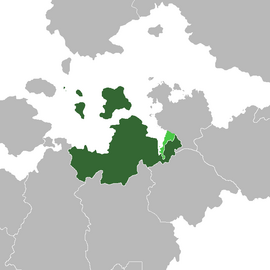 | |
| Largest largest city | Gadkheri |
| Official languages | Tapakdi, Peshbi, Burgoignesc |
| Ethnic groups | Primarily Tapakdan, with minority Peshabi, and Kashmiris |
| Religion | Primarily Buddhism, with minority Sikhism, Hinduism, Jainism |
| Demonym(s) | Tapakdori |
| Government | Monarchy |
• Queen | Chandrika IV |
| Establishment | |
• Independence | 1811 |
| Area | |
• Total | 728,511.856 km2 (281,280.000 sq mi) |
| Population | |
• 2028 estimate | 48,016,260 |
• Density | 65.910/km2 (170.7/sq mi) |
| GDP (nominal) | estimate |
• Total | $825,895,037,203.20 |
• Per capita | $17,200.32 |
| Currency | Common Middle Sea Florin (CMS ƒ) |
| Driving side | right side |
Tapakdore, officially the Queendom of Tapakdore is a developing nation in the Audonian region of Daria. It is bound by the Aab-e-Farus in the north, Pukhgundi in the northeast, Dhavastu in the south, and Umardwal in the west. Its capital and coastal regions are becoming more heavily urbanized with its interior remaining largely rural.
Tapakdore has an absolute monarchy who fills the role of both legislature and executive, and a supreme court, which has been criticized for being a puppet of the monarch.
It is a member of the League of Nations, the International Red Cross and Red Crescent Movement, and many other international organizations.
It is an emerging market, market economy focused on exports, under the watchful eye of Burgundie whose companies have a massive stake in the country's economic activity. It is an active leader in the Middle seas region's economic activity. Recently, exploration companies from Burgundie have found evidence of deposits of rare earth metals that will be mined in the near future. There are fishing, ship breaking, and recycling economies that Burgundie is also investing in to expand and connect to the global trade network. During the colonial period it was a rich source of rubies and sapphires, many of which are featured in the royal scepter and orb of the Great Prince of Burgundie.
Many scholars have criticized its economic governance and politics, arguing that it is merely a client of the Burgoignesc thalattocracy's economic and cultural might.
The people of Tapakdore are predominantly culturally Tapakdi, Peshabi or Kashmiris, speak Tapakdi or Peshbi, and Burgoignesc, and most practice Buddhism, with minorities of Sikhism, Hinduism, or Jainism adherents.
Geography

Forming a natural border with Pukhgundi in the far east, the Machhapuchhre mountains dominate the skyline with elevations exceeding 4,501 meters. These majestic peaks create a rugged and imposing landscape, potentially influencing the region's climate, biodiversity, and cultural identity. The western frontier of Tapakdore is marked by the Indukoush Mountains, a formidable barrier separating the country from Umardwal. These rugged peaks reach elevations of over 3,000 meters, creating a challenging terrain that has shaped the region's historical and cultural development. Nakals Kandu Vetiya are located in the south-central part of Tapakdore, with their unique flora and fauna, contribute to the overall biodiversity of the region. Ran Thambilu Thanna (Tapakdi for "Golden Plains"), are a fertile region that supports agricultural activities and contributes to the country's food production. The proximity to the sea and the rich soil make this area ideal for cultivation. Flowing through the western plains, the Sindhus River forms a natural border between Tapakdore and Umardwal. This vital waterway not only demarcates the national boundary but also serves as a source of irrigation, transportation, and livelihood for the communities residing along its banks. Tapakdore's extensive coastline along the Aab-e-Farus is a defining feature of its geography. The coastal region is home to the capital city and other major urban centers. The Aab-e-Farus provides Tapakdore with access to maritime trade routes, fishing grounds, and potential for tourism development.
Tapakdore's diverse geography has profoundly influenced its society and economy. The fertile plains support agricultural activities, while the mountains provide natural resources and opportunities for tourism. The coastal region, with its access to the sea, has fostered trade and urbanization. The country's varied terrain also poses challenges for transportation and communication, particularly in the mountainous regions. However, the government has made efforts to improve infrastructure, constructing roads, bridges, and tunnels to connect different parts of the country.
Climate and environment
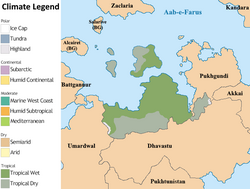
Tapakdore's climate is predominantly tropical, characterized by high temperatures and abundant rainfall throughout the year. The majority of the country experiences a tropical wet climate. This climate zone is characterized by consistent warmth, high humidity, and substantial precipitation, creating lush rainforests and fertile agricultural lands. However, the topography of Tapakdore plays a significant role in creating variations in climate across the country. The presence of mountain ranges like the Machhapuchhre in the east and the Indukoush in the west creates a rain shadow effect. As moisture-laden trade winds blow in from the east, they are forced to rise over the mountains, cooling and condensing, resulting in heavy rainfall on the windward (eastern) slopes. The leeward (western) sides of these mountains receive significantly less rainfall, leading to a drier tropical climate. The highlands of the Machhapuchhre and Indukoush Mountains experience a unique highland climate characterized by cooler temperatures, lower humidity, and distinct wet and dry seasons. This cooler climate supports different vegetation zones and agricultural practices compared to the lowland tropical areas. The capital city, located in the central plains, enjoys a humid subtropical climate. This zone is characterized by hot, humid summers and mild winters, with moderate rainfall throughout the year. The combination of warmth and moisture creates favorable conditions for agriculture, contributing to the region's economic productivity.
As a developing nation, Tapakdore faces environmental challenges, including deforestation, pollution, and the impacts of climate change. The government and various organizations are working to address these issues through sustainable development initiatives and conservation efforts.
History
Prehistory
Battganuur was originally settled by Indo-Aryan peoples who likewise settled areas from Zaclaria to Pukhgundi. These people shared languages with common roots, the Indo-Aryan languages which later diverged into Proto-Umardonian (west of the Sindhus River) and proto-Sindhus (east of the Sindhus River).
Umaronid Empire
The Umaronid Empire, a Bronze Age civilization that thrived in western Audonia from approximately 3300 to 1300 BCE, left an indelible mark on the region. Renowned for their meticulous urban planning, the Umaronids constructed sprawling cities like Harappa and Mohenjo-daro, characterized by grid-like layouts, multi-story houses, and sophisticated drainage and water supply systems. This meticulous attention to detail extended to their economic practices, evident in their standardized weights and measures that facilitated trade and commerce across the empire. The Umaronids demonstrated exceptional craftsmanship and technological ingenuity. Their mastery of metallurgy is evident in the production of bronze tools and weapons, while their artistry is showcased in intricate seals, pottery, and figurines. Notably, the empire developed a unique script, yet to be deciphered, which tantalizingly hints at a complex language and potentially rich literary traditions. Despite its advancements, the Umaronid Empire eventually declined. While the precise reasons remain unclear, factors such as climate change, shifting river courses, and migrations likely played a role. Nevertheless, the legacy of the Umaronids endures, providing valuable insights into the social, economic, and cultural dynamics of early Audonian civilizations. The empire's contributions to urban planning, metallurgy, and artistic expression continue to inspire and inform contemporary understanding of the region's history.
Classical Antiquity
Modern Tapakdore fell under the Arunid Empire during classical antiquity. western Tapakdore was part of the province of Kashmiria with parts of northern Umardwal, ruled by Kashmiri princes. It was important to the empire with its textile industry and trade routes on Sea of Kandahar and the Aab-e-Farus. It became a hub of learning and culture and served as the crossroads between the Arabo-Persian and the Punjabo-Nepali areas of the Arunid Empire. The Kashmiri princes who ran Kashmiria were violent subjugators of the proto-Persian culture in the area and forced the creation of the Ifgeen culture as unique from the proto-Persian culture in what would become northern Battganuur. The eastern part of Tapakdore was part of the core administrative Kingdom of Pondichundie that formed the base of the empire, with most of modern Pukhgundi.
The Arunid Empire, a sprawling realm stretching across Daria and beyond from 372 BCE to 884 CE, left an enduring legacy on the regions it encompassed. Tapakdore, nestled within the empire's embrace, experienced a transformative period marked by economic prosperity, cultural exchange, and integration into a complex imperial system. Tapakdore's geological riches, particularly its abundant deposits of rubies and sapphires, played a pivotal role in its integration and significance within the Arunid Empire. These precious gemstones were sought after by the empire's elite for personal adornment and as symbols of status and power. Tapakdore's gem trade flourished, contributing significantly to the imperial treasury and elevating the region's economic standing. The extraction and trade of these gemstones not only generated revenue but also fostered the development of skilled craftsmanship and artistry within Tapakdore. Beyond its gemstone wealth, Tapakdore's coastal location on the Aab-e-Farus granted it a strategic advantage as a maritime nexus. Its ports bustled with activity, serving as vital gateways for trade between the empire's interior and the wider world. Merchant vessels laden with spices, textiles, and other valuable commodities from distant lands traversed Tapakdore's waters, enriching the region and connecting it to diverse cultures and civilizations. This maritime trade fueled economic growth and fostered a cosmopolitan atmosphere within Tapakdore, as merchants, sailors, and travelers from various corners of the empire converged in its ports.
The Arunid Empire's ethos of religious tolerance and cultural inclusivity created a fertile ground for cultural exchange and diversity within Tapakdore. The region became a confluence of various cultural influences, with Pukhti, Persi, and Istroyan traditions intermingling with indigenous customs. This cultural synthesis is evident in Tapakdore's architectural heritage, artistic expressions, and religious practices, which showcase a blend of diverse styles and beliefs. The vibrant cultural landscape of Tapakdore during the Arunid era was a testament to the empire's cosmopolitan spirit and the region's ability to absorb and adapt to external influences. Under the Arunid Empire's centralized administration, Tapakdore experienced a period of structured governance and integration into a vast imperial system. Imperial policies and regulations shaped the region's administrative framework, ensuring a degree of uniformity and consistency across the empire. However, the empire's recognition of local customs and traditions allowed Tapakdore to retain a degree of autonomy in matters of local governance. This approach fostered a sense of belonging and cooperation among the region's inhabitants, facilitating their integration into the larger imperial structure. The dissolution of the Arunid Empire in 884 CE marked a turning point for Tapakdore. The religious tolerance ended under the Oduniyyad Caliphate and attempts at cultural homogenization meant that some of traditions of the natives were lost to time.
Medieval period and the Sultanate of Ruhunu Pura
The Sultanate of Ruhunu Pura traces its origins to the ancient Tapakdi kingdom of Ruhuna. With the arrival of Islam through Arab traders, Ruhuna gradually adopted the faith, blending it with existing Tapakdi customs and Buddhism. The Oduniyyad Caliphate recognized Ruhunu Pura's strategic importance for trade in the Aab-e-Farus, establishing it as a sultanate. The Sultan of Ruhunu Pura is the head of state and government, advised by a council of ministers (Diwan) drawn from the nobility and religious scholars. Local administration is handled by regional governors (Disawe) and village headmen (Grama Niladhari). The sultanate follows Islamic law (Sharia) alongside traditional Sinhalese legal customs. Ruhunu Pura is a prosperous trading hub, renowned for its spices (cinnamon, cardamom), gemstones (sapphires, rubies), and textiles (silk, cotton). Its ports are bustling with ships from all across Audonia. Agriculture also thrived, producing rice, coconuts, and tropical fruits. Both Ruhunu Pura enjoyed considerable autonomy within the Oduniyyad Caliphate, contributing to its cultural and economic diversity, and it benefit from the Caliphate's vast trade networks and military protection, while retaining some of its unique identities and traditions.
Warring Century
The Warring Century, a period of immense upheaval and unrest cast a long, devastating shadow over the history of Tapakdore. The repercussions of the Oduniyyad Caliphate's collapse and the subsequent sectarian violence rippled across borders, profoundly weakening Tapakdore's political and economic structures. The disruption of the Silk Road, a vital trade artery connecting East and West, crippled Tapakdore's economy. As trade routes became perilous and costs soared, Tapakdore's merchants faced bankruptcy, and essential goods became scarce, causing widespread hardship and discontent among the populace. The emergence of the Southern Route, bypassing the war-torn Daria region altogether, further isolated Tapakdore, deepening its economic woes and leaving it vulnerable to external influence. The influx of refugees and migrants seeking safety in Tapakdore strained the nation's resources and infrastructure, exacerbating social tensions. The diverse cultural practices and religious beliefs of the newcomers clashed with established traditions, creating a volatile atmosphere ripe for conflict. The escalating violence in the region also destabilized Tapakdore's internal security. Bandits and marauders, emboldened by the chaos, preyed on vulnerable communities, further eroding public trust in the ruling elite. The once-strong military, burdened by dwindling resources and internal divisions, struggled to maintain order, leaving the nation vulnerable to external threats. The Warring Century's religious strife also took its toll on Tapakdore. The sectarian violence witnessed in the Daria region fueled religious tensions within the country, undermining the previously harmonious coexistence of diverse faiths. The resulting social fragmentation weakened the fabric of society, making it easier for external powers to exploit internal divisions. In the aftermath of the Warring Century, Tapakdore emerged as a weakened and fractured nation, ripe for exploitation. Its economy was in ruins, its social fabric torn, and its military depleted. The once-proud nation, now vulnerable and desperate, was an easy target for opportunistic colonial powers seeking to expand their empires.
Early modern history
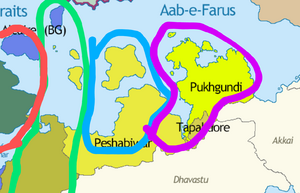
*Red- Barbary Straits colony
*Green- Kandahari-Pukhtun colony
*Blue- Peshabiwar colony
*Purple- Pukhgundi colony
Starting with the fall of the Oduniyyad Caliphate in 1517 and lasting until the expulsion of the Marialanii Ularien Trading Company in 1836 and the Bourgondii Royal Trading Company in 1842, the early modern era in Battganuur was characterized by rapid development, and unprecedented resource and human exploitation.
Peshabiwar colony was a charter colony established by the Duchy of Martilles in 1592, following the Great Confessional War. The colony's initial settlers were Protestant refugees who had been expelled from the Holy Levantine Empire. These devout Calvinists, driven by ambition and a desire to rebuild their lives, sought to establish a new homeland in Tapakdore. Peshabiwar quickly became an economic powerhouse, thanks to its strategic location along the western Silk Road. The colony's fertile land and favorable climate proved ideal for cultivating lucrative cash crops such as sugarcane, pineapples, millet, cotton, and tea. These exports fueled the colony's wealth and attracted further investment from Martilles. However, the colony's prosperity was not solely based on agriculture. Peshabiwar also played a significant role in the slave trade, serving as a major transit point for Ebidi slaves sourced from various colonies in the region. The opening of the Southern Route by the Daxians, diverting trade eastward to Sarpedon, posed a challenge to Peshabiwar's economic dominance. However, the colony's established trade networks and diversified economy allowed it to adapt and maintain its position as a regional economic hub. Over time, Peshabiwar expanded its territory through a combination of military conquest, political maneuvering, and the application of the doctrine of lapse. This doctrine, which allowed Martilles to annex territories where the ruling lineage had died out or was deemed incompetent, facilitated the colony's gradual expansion throughout central Tapakdore. The colonial administration, deeply influenced by Calvinist principles, implemented a strict and efficient system of governance. The colony's laws and institutions reflected the settlers' religious beliefs and their commitment to social order and economic prosperity. By the early 18th century, Peshabiwar had achieved remarkable self-sufficiency. The colony had developed its own distinct political traditions, a thriving economy, a complex social structure, and a well-trained military force. This autonomy and resilience allowed the colony to weather challenges and maintain its status as a vital part of the Martillien empire.
Late modern period

Following the dissolution of the Peshabiwar Colony in 1807, Tapakdore embarked on a tumultuous journey towards self-determination. The post-colonial era was marked by political instability, economic struggles, and social unrest. The departure of the Martillien administration left a power vacuum, leading to the rise of competing factions vying for control. The early years of independence were characterized by a series of short-lived governments, plagued by corruption, mismanagement, and internal strife. The economy, once heavily reliant on colonial trade and agriculture, struggled to adapt to the new global order. Social inequalities, exacerbated by the legacy of colonialism, fueled discontent among marginalized communities. The 1920s and 1930s witnessed a surge in nationalist movements, demanding greater political representation and economic reforms. These movements often clashed with the ruling elite, leading to violent confrontations and political repression. The onset of World War II further destabilized the country, as Tapakdore became entangled in the global conflict, experiencing economic hardship and social upheaval. By 1943, Tapakdore was a nation mired in poverty, political turmoil, and social divisions. The scars of colonialism and the wounds of internal conflict had left the country vulnerable and in dire need of stability and direction.
Contemporary period
The turning point in Tapakdore's history came in the 1960s with Operation Kipling, a series of economic and infrastructure development programs initiated by Burgundie. These investments aimed to modernize Tapakdore's economy, improve infrastructure, and foster social development. The impact of Operation Kipling was profound and far-reaching. It spurred rapid industrialization, urbanization, and technological advancements. New factories were built, creating employment opportunities and stimulating economic growth. Infrastructure projects, such as roads, railways, and power plants, connected remote regions and facilitated trade. The investment in education and healthcare led to significant improvements in literacy rates and life expectancy. The government, with Burgundian support, implemented social welfare programs to address poverty and inequality. The modernization drive also led to a cultural renaissance, as Tapakdore embraced new ideas and technologies while preserving its unique heritage. The rise of a new middle class, fueled by economic growth and educational opportunities, transformed the social landscape, creating a more dynamic and aspirational society. However, the rapid modernization also brought its own set of challenges. Urbanization led to overcrowding, pollution, and social displacement. The gap between rich and poor widened, creating new social tensions. The country also faced environmental challenges, as industrialization and deforestation took their toll on the natural landscape.
Politics and government
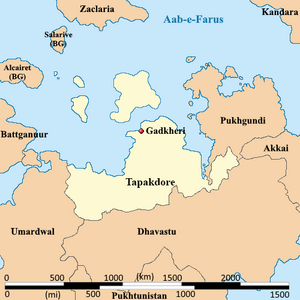
Tapakdore is governed by an absolute monarchy, wherein the reigning monarch wields both legislative and executive powers. This system of governance vests supreme authority in the monarch, who serves as the head of state and government. The monarch is responsible for formulating and enacting laws, directing the executive branch, and overseeing the administration of justice. The current monarch of Tapakdore is the Queen Chandrika IV, who inherited the throne through hereditary succession from her mother Padmavati II. The line of succession typically follows primogeniture, with the eldest daughter of the monarch, inheriting the throne. The monarch is assisted by a council of advisors, composed of members of the royal family, religious leaders, and other influential figures. This council provides counsel and support to the monarch in matters of governance and policy-making. The judiciary in Tapakdore is nominally independent, with a supreme court serving as the highest judicial authority. However, the judiciary has faced criticism for its perceived lack of independence from the monarchy, raising concerns about the fairness and impartiality of the judicial process. While the absolute monarchy system has provided stability and continuity in Tapakdore's governance, it has also faced criticism for its concentration of power and lack of democratic accountability. Concerns have been raised about the protection of individual rights, freedom of expression, and political participation in the absence of a representative legislature. In recent years, there have been calls for political reforms, including the establishment of a constitutional monarchy or a parliamentary system, to introduce greater checks and balances on the monarch's power and enhance democratic representation. However, these calls have faced resistance from conservative elements within the government and society who advocate for maintaining the traditional system of absolute monarchy.
Subdivisions
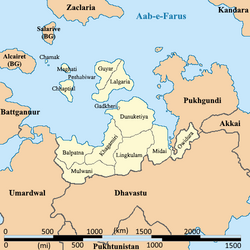
- Balpatna
- Chamak
- Chhaptial
- Dunuketiya
- Gadkheri Capital District
- Guyar
- Khagamiri
- Lalgaria
- Lingkulam
- Maghati
- Midai
- Mulwani
- Owidura
Military
-
Tapakdori National Gendarmerie
-
Tapakdori National Gendarmerie
Tapakdore maintains a modestly sized military force, primarily focused on safeguarding national security and protecting the country's borders. The number of eligible candidates are limited by the significant portions of the population being religiously non-violent. The composition of the military reflects a balance between ground forces, maritime defense capabilities, and a small air force contingent.
Royal Army
The Royal Army of Tapakdore, consisting of specialized divisions and brigades, has leveraged surplus military materiel from nations in the Middle seas region and Burgundie to bolster its defense capabilities. The Army of the Great Plains, the Army's motorized infantry division is postured to operate across expansive terrains of the western and central parts of the country, has been equipped with surplus motorized vehicles, including trucks, armored personnel carriers, and utility vehicles, sourced from friendly or sympathetic nations. This surplus materiel has significantly enhanced the mobility and operational effectiveness of the division, enabling rapid deployment and maneuverability on the plains. The Army of the Heights, specializing in mountain warfare, has benefited from surplus cold-weather gear, specialized mountaineering equipment, and rugged terrain vehicles procured through collaborative agreements with Burgundie. These provisions have equipped the division to effectively navigate and operate in challenging mountainous environments, ensuring the readiness of Tapakdore's forces in high-altitude regions along its border with Pukhgundi in the east.
The Army of the Mounted Men is the Army's armored cavalry unit, enhancing the Army's direct and indirect firepower and reconnaissance capabilities. It consists of a light and a heavy cavalry regiment, the former a wheeled unit used primarily for force recon following Burgoignesc doctrine and the latter a heavier, tracked unit with AMY-82 tanks supplied by Burgundie (which it purchased from Yonderre when that country began replacing them in 2016) that is used more for direct engagements with its neighbors, should they invade.
Moreover, the training and advisory support provided to the Royal Army of Tapakdore have been primarily facilitated by the Treaty Observation Corps of the National Gendarmerie of Burgundie. This collaboration has enabled the Tapakdorean forces to benefit from advanced military training programs, tactical expertise, and strategic guidance, fostering the professional development of the army personnel and enhancing their operational readiness. The expertise shared by the Treaty Observation Corps has contributed to the modernization and professionalization of the Tapakdorean military, strengthening its capacity to respond effectively to evolving security challenges in the region.
Royal Maritime Defense Force
Tapakdore maintains a small but competent naval/coast guard fleet responsible for safeguarding the nation's limited coastal waters and maritime interests. This naval force focuses on maritime surveillance, coastal defense, and sovereignty patrols, ensuring the security of it's territorial waters.
Royal Air Force
The Tapakdori Royal Air Force comprises a modest fleet of aircraft, including transport planes and a limited number of fighter jets for air defense purposes. The air force is primarily tasked with conducting aerial surveillance, providing logistical support for ground operations, and ensuring the protection of Tapakdore's airspace.
Tapakdore maintains a non-aggressive stance in regional affairs, prioritizing diplomatic solutions and peaceful coexistence with its neighboring countries. The nation actively participates in international peacekeeping missions, showcasing its commitment to global security and stability. Furthermore, Tapakdore fosters cooperative defense initiatives and partnerships with neighboring nations and international organizations, emphasizing the importance of collaborative security measures and mutual defense agreements in the Middle Seas region.
Society and culture
-
Tapakdi schoolgirls
-
Tapakdi monk
-
Tapakdi man
-
Peshabi man
-
Young Peshabi man
-
Hip Peshabi man
-
Peshabi woman
-
Peshabi woman
-
Kashmiri youth
-
Kashmiri man
-
Kashmiri boys
-
Kashmiri schoolgirls
-
Kashmiri men
The Tapakdi people comprise the majority of Tapadore's population (58%), followed by Peshabi (28.8%), Kashmiris (7%), and Occidentals (1.2%). This ethnic diversity is reflected in the linguistic landscape, with Tapakdi being the most widely spoken language (78.56%), followed by Peshabi (45.53%) and Burgoignesc (15%). The multilingual nature of Tapadore's society fosters cultural exchange and understanding. Buddhism plays a central role in Tapadore's society and culture, with 46% of the population adhering to this faith. Its teachings and philosophies heavily influence the country's values, ethics, and worldview. Other significant religions in Tapakdore include Sikhism (26.5%), Hinduism (12.5%), Jainism (7.3%), and Christianity (5.2%). Despite the dominance of Buddhism, Tapakdore maintains religious tolerance and respects the diverse beliefs of its citizens.
Education is highly valued in Tapakdore, with a strong emphasis on both traditional knowledge and modern scientific disciplines. The education system aims to cultivate well-rounded individuals who are rooted in their cultural heritage while also being equipped to contribute to a globalized world. Schools and universities often incorporate religious teachings, particularly Buddhist principles, into their curriculum. Tapakdi society is characterized by a strong sense of community, respect for elders, and a deep appreciation for nature. The Buddhist concept of interconnectedness influences social interactions, promoting compassion, empathy, and non-violence. The country's worldview is often described as holistic and spiritual, with a focus on personal well-being, inner peace, and the pursuit of enlightenment. Family plays a crucial role in Tapakdi society, with extended families often living together in multi-generational households. The elderly are revered for their wisdom and experience, and children are taught to respect their elders and uphold family traditions. Marriage is considered a sacred union, and weddings are elaborate celebrations that reflect the country's cultural heritage.
Tapakdi cuisine is a flavorful fusion of Tapakdi, Peshabi, Kashmiri, and Occidental culinary traditions. Rice and curry are staple dishes, often accompanied by various vegetables, meats, and fish. Spices play a prominent role in Tapakdi cooking, adding depth and complexity to flavors. Vegetarianism is also common, influenced by Buddhist principles of non-violence towards animals. Tapakdore boasts a rich artistic heritage, with its art, literature, and architecture reflecting the country's diverse cultural influences. Buddhist temples, adorned with intricate carvings and colorful murals, are architectural landmarks that showcase the country's devotion to its faith. Traditional music, dance, and theater performances are integral to cultural celebrations and festivals, showcasing the country's vibrant artistic expressions. The national flag, emblem, and anthem of Tapakdore are symbols of its sovereignty, cultural heritage, and national identity. The lion, a prominent symbol in Tapakdi culture, often features in national emblems and represents courage, strength, and pride. The Dharmachakra, a sacred symbol in Buddhism, signifies purity, enlightenment, and spiritual growth and is featured as the central image of the national flag.
Sports play a significant role in Tapakdi society, fostering national pride and unity. Cricket is the most popular sport, followed by volleyball, football, and athletics. The country actively participates in international sporting events, showcasing its athletic talent and competitive spirit.
Linguistic Demographics

78.56% of the population can speak Tapakdi, 45.53% of the population can speak Peshabi, and 15% of the population can speak Burgoignesc.
The Tapakdi people who account for 58% of the population of Tapakdore speak Tapakdi as their primary language. The Peshabi community (28.8% of the population) uses Peshabi primarily, but over half also have a proficiency in Tapakdi. Similarly, while Peshabi reigns supreme among the minority Kashmiris, roughly 18% possess the ability to communicate in Tapakdi. Burgoignesc holds the position of the second language due to Tapakdore's strong economic ties with Burgundie. This makes Burgoignesc the language of choice for business and international dealings. Notably, educated professionals across all ethnicities, particularly those in business and government, exhibit proficiency in Burgoignesc. The primary and secondary education system in Tapakdore teaches Tapakdi and Burgoignesc to all students as a separate language course of study, but all other topics are studies in either Tapakdi or Peshabi. In tertiary academic settings courses are taught either only in Tapakdi or Burgoignesc unless the field of study is related directly to the sociology, history, or anthropology of the Peshabi-speaking people.
The Tapadki language while originally and still written in the Tapadki script, has, as of 1994, a Latinized alphabet which is becoming more commonly used.
Religious Demographics
-
Front view
-
Mandapa roof
-
Buddhist temple
-
Hindu temple
Buddhism is the cornerstone of Tapakdore's religious make up, 46% of the population of the nation are its adherence. Its arrival in Tapakdore came through the conversion of Emperor Ashoka of the Arunid Empire in the 3rd century BCE. Mahayana Buddhism, emphasizing compassion and the potential for all beings to achieve enlightenment, is the dominant school of thought within the country. Buddhism is practiced by all ethnic groups but its ethnographic center is among the Tapakdi people.
Sikhism constitutes a substantial 26.5% of Tapakdore's religious identity. Sikhism's emphasis on social justice, equality, and standing up for the oppressed likely resonated with the Pehsabi people who faced marginalization during the Oduniyyad Calphate. The presence of Sikh Gurus in their disciples in modern Tapakdore is attested to in the 16th or 17th centuries. Peshabi Sikhism was fostered by the Martillian colonizers of the Peshabiwar colony who wanted to ensure that there was no native common cause with the Buddhists in the Duchy of Bourgondi's Pukhgundi colony. However, the establishment of Gurdwaras (Sikh places of worship) across the nation serves as a testament to the faith's enduring presence. The harmonious coexistence of Sikhism with Buddhism in modern Tapakdore is commonly attributed to shared values of compassion, ethical conduct, and a focus on achieving enlightenment. Sikhism is predominately practiced by the Peshabi and to a certain extent Kashmiri people.
Hinduism is practiced by 12.5% of Tapakdore's population. The arrival of Hinduism is also a result of the country being a part of the Arunid Empire. The presence of Hindu temples and iconography in archaeological sites suggests a period of flourishing Hinduism within Tapakdore, perhaps as a rejection of the rise of Zoroastrian influences in the court practices of Buddhism starting in the 4th century CE. However, the court religion, ostensibly being Buddhism, and the influence of Jainism led to a decline in the prevalence of Hinduism over time, which was one of the largest religions outside of Islam in the region under the Oduniyyad Calphate. Nevertheless, Hinduism continues to hold significance for a dedicated segment of the population. Hinduism is strong in the southwest of the country where the populations are majority Kashmiri with some Peshabi people also practicing.
Jainism constitutes 7.3% of the religious population. Jain philosophy, emphasizing strict vegetarianism, ethical conduct, and detachment from worldly possessions, may have attracted individuals seeking a more ascetic way of life, but never drew large numbers to its casue. Considered fringe, fanatic, and fundamentalist by most Tapakdoris, there a few communities along the southern border that are the strongholds of Jainism in Tapakdore.
Christianity, in its various denominations, represents a minority of 5.2% within Tapakdore. Its arrival occurred during the colonial period and missionary activities in the 17th and 18th centuries. They are predominantly Protestant, Mercantile Reform Protestantism is the chief among them. The remaining 2.5% of the population either identify with other religions or do not subscribe to any particular faith. It is mostly practiced along the coast, particularly in the islands of Peshabiwar.
Impact of the foreign workforce
Tapakdore's large foreign workforce has increased the large diaspora of many nationalities, with the majority coming from South Crona. The Qabóri-Audonian Employment Program was created in 1939 by Woqali Satola Sanleć, and was originally intended as a second-chance program for convicted Tierradorian, Porlosi, and Ceylonian felons. However, as the program grew, it began to allow any South Cronan national, regardless of background, to seek overseas employment in Burgoignesc Audonia. Tapakdore, along with Umardwal, host the most Tierradorian foreign workers out of any country, at 29,000, and the Tierradorian diaspora is very prominent in Umardwal. Tierradorian cuisine has grown in popularity in Audonia, with many local Poraqal-style restaurants with an Tapakdori and Umardi twist being seen throughout both the countries.
Architecture
Predominantly shaped by Tapakdi Buddhist traditions, it also incorporates elements from Peshabi, Kashmiri, and Occidental styles, creating a unique architectural landscape. Buddhist temples, or Viharas, stand as the most prominent structures, adorned with intricate carvings, vibrant murals, and natural materials. Hindu temples, known as Kovils, showcase colorful sculptures, towering gateways, and pillared halls, reflecting the influence of the Tamil community. Sikh Gurdwaras, with their simple elegance, serve as places of worship for Sikhs. Mosques and churches cater to the Muslim and Christian communities, while traditional houses, known as Walauwas, showcase adaptations to the tropical climate. Remnants of the Occidental influence can be seen in colonial-era buildings, often characterized by Occidental architectural styles. As Tapakdore progresses, modern architecture emerges, incorporating contemporary design elements while drawing inspiration from traditional motifs. Common architectural elements like moonstones, lotus ponds, and dragon arches adorn many structures, adding to their cultural significance. While facing challenges in preservation due to urbanization and natural disasters, efforts are underway to conserve this rich architectural heritage, ensuring it continues to reflect Tapadore's history, spirituality, and evolving identity.
Economy and infrastructure
Tapakdore, is nestled in the Middle seas region, and is known for its rich natural resources and diverse landscape, comprising a pristine coastline in the west, expansive plains in the central region, and a formidable mountain range in the east, where rubies and sapphires are mined. Despite its potential, the nation has faced numerous challenges in developing a robust and sustainable economy.
The mining sector, while a source of valuable gemstones, has been marred by underregulated practices, leading to environmental degradation and exploitation of local communities. However, with the support and guidance from nations like Burgundie and others in the Middle seas region, Tapakdore has been gradually implementing some regulations to foster more ethical and sustainable mining practices. The introduction of modern technologies and the establishment of community development initiatives have begun to transform the mining sector into a more responsible and transparent industry, contributing to the nation's emerging market economy.
The agricultural sector has undergone a significant transformation, with the implementation of modern techniques and infrastructure improvements, also sponsored by Burgundie. The nation's fertile plains have become a hub for the cultivation of a variety of crops, like rice, wheat, and sorghum, ensuring food security and creating opportunities for agricultural exports. With the aid of neighboring countries, Tapakdore has invested in agricultural infrastructure like irrigation and renewable power generation projects.
The manufacturing sector, though in its early stages, has shown promise as the nation endeavors to capitalize on its availability of raw materials. With guidance and investment from the Middle seas region nations and Burgundie, Tapakdore is fostering the growth of local industries, focusing on full-cycle internal products (products whose raw materials are available in Tapakdore, can be turned into finished products in the country, and bought and used by the Tapakdori people) and the development of skilled labor, contributing to the overall economic diversification of the country.
However, one of the more contentious aspects of Tapakdore's economy has been the shipbreaking industry, which, until recently, operated with minimal oversight and safety regulations, posing significant risks to workers and the environment. Recognizing the need for reform, Tapakdore has begun collaborating with its regional partners to implement comprehensive safety measures and enforce stringent environmental standards, ensuring the sustainable development of the shipbreaking sector.
Despite the challenges, Tapakdore's export market has shown promising signs of growth, albeit at a slower pace than anticipated. With the support of neighboring nations in the Middle seas region and Burgundie, Tapakdore is exploring new avenues for expanding its export market, capitalizing on its natural resources and the growing demand for high-tech products. Through collaborative efforts and strategic partnerships, the nation is gradually establishing itself as a reliable exporter of gemstones, agricultural goods, and ethically manufactured products, contributing to the steady progress of its emerging market economy.
Standard of living
In urban areas, particularly the capital and major cities, the standard of living has seen noticeable improvements in the last few decades. Access to basic amenities such as clean water, electricity, and sanitation has become almost ubiquitous, thanks to ongoing infrastructure development initiatives supported by neighboring nations in the Middle seas region and Burgundie. Modern housing complexes and improved urban planning have contributed to a more comfortable and sustainable urban lifestyle.
However, rural areas still grapple with limited access to essential services and infrastructure, posing challenges to the overall standard of living. Despite advancements in the agricultural sector, some remote farming communities continue to face difficulties in accessing quality healthcare, education, and reliable transportation. Efforts to bridge the urban-rural divide have been underway, focusing on improving connectivity and providing targeted support for rural development projects, however, those areas which are deemed as key routes for new infrastructure for developing a stronger export market are being prioritized.
The education sector has also seen significant progress, with increased access to primary and secondary schooling across the nation. Government initiatives, in collaboration with international partners, have aimed to improve the quality of education, focusing on enhancing curriculum standards and providing training for educators. This has opened up new opportunities for the younger generation, enabling them to acquire the necessary skills to contribute to the country's evolving economy. The ultimate goal is to meet the Burgogignesc standard of Total Economic Engagement whereby all able-bodied people in the country are contributing to the nation's economy.
Healthcare services have also undergone significant improvements, with the establishment of more healthcare facilities and the deployment of trained medical professionals in various regions in a capacity building effort to train locals to be medical professionals themselves. Efforts to expand healthcare coverage and promote preventive healthcare measures have led to a reduction in certain preventable diseases and an overall increase in life expectancy.
Despite these advancements, income disparities and socio-economic inequalities remain prevalent, creating challenges in ensuring a consistently high standard of living for all citizens. Efforts to address these disparities are ongoing, with a focus on promoting inclusive economic growth and a sustainable distribution of resources. Through collaborative efforts between the government, international partners, and local communities, Tapakdore continues its journey toward enhancing the overall standard of living and ensuring a better quality of life for all its people.
Agriculture
-
Darjeeling tea worker
-
Tea factory in Mulwani
-
Tea resort in Owidura
-
Sugarcane plantation in Dunuketiya province
-
Sugarcane processing mill
Tea and sugar are the two primary agricultural products and exports of Tapakdore. Between the two of them, they employ almost 30% of the labor force and make up significant portions of the country's commodity market.
The north coast and Lalgaria province have a tropical wet climate. Here, the prevailing easterly tradewinds sweep moisture from the Aab-e-Farus, making the growing seaon yearround with abundant rainfall. The cultivation of basmati rice is prevalent and it is a staple food across Tapakdore. Paddy fields dominate the landscape, with massive, publicly owned irrigation systems ensure a consistent water supply for this high-moisture crop, from which farmers draw their water and pay the municipality by the kiloliter. Beyond rice, massive plantations, remnants of the latifundia of the Burgoignesc colonial empire, flourish with banana, coconut, pineapple, mangoes and sugar cane. Corporate rubber plantations are also common. In the interior, sorghum and millet grains are the staple of local diets with limited export marketability. Cotton is the primary cashcrop for export. Its largescale cultivation dates back to the Burgoignesc colonial empire, particularly the Pashabiwar colony. Root vegetables like cassava and sweet potatoes are also cultivated for local consumption in the interior.
In the Owidura and Mulwani provinces, situated in the extreme east and west of Tapakdore respectively, there are highland climates. Characterized by cooler temperatures and significant variations throughout the year, these regions require crops that can tolerate not only drier conditions but also cooler nights and potentially even frost at higher elevations. Here, temperate fruits like apples, pears, peaches and plums are cultivated. Vegetables like potatoes, cabbage, broccoli, and carrots are also grown in these areas. However, all of these crops pale in comparison to the scale of the tea estates. Tea, especially Darjeeling, is the primary cash crop and backbone of the economies of the areas in which they are cultivated. Tea estates employ either directly or indirectly most of the communities they touch.
Films, entertainment, and music industry
The Tapakdi film, entertainment, and music industry, often referred to as Tapakdiwood, is a global entertainment powerhouse known for its prolific output and cultural significance. Tapakdiwood produces films in various languages, with Tapakdi cinema being the most prominent. The industry churns out hundreds of films annually, spanning diverse genres from romantic comedies and action thrillers to historical dramas and musicals. These films often feature elaborate song-and-dance sequences, reflecting the vibrant culture of Tapakdore. Tapakdiwood's influence extends beyond Daria and the Middle seas region, with audiences worldwide enjoying its unique storytelling and visual spectacle. The industry has also played a pivotal role in promoting Tapakdi music, encompassing both traditional genres like classical and folk music and contemporary styles like pop and hip-hop. Tapakdi music is enjoyed for its rich melodies, driving rhythms, and evocative lyrics, often intertwined with the narratives of Tapakdiwood films.
Manufacturing
Shipbreaking

Tapakdore's shipbreaking industry offers a significant source of raw materials and employment opportunities, but it has also been historically marred by safety concerns and environmental hazards. Shipbreaking, the dismantling of aged, obsolete, or irreparable vessels that have reached the end of their operational lifespans. These ships are brought to Tapakdore, primarily from developed nations, where stricter environmental regulations and safety standards make the process costlier, to be disposed of. For Tapakdore, shipbreaking presents an attractive opportunity to acquire steel, a vital resource for its growing manufacturing sector. The recovered steel is reprocessed and utilized in various industries, from construction and automotive parts to appliances and machinery. This influx of steel contributes to Tapakdore's economic development and reduces its dependence on virgin ore imports. The shipbreaking industry in Tapakdore is heavily reliant on manual labor. Workers, often with limited safety gear and training, are tasked with the dangerous job of dismantling these ships. Works cut through layers of steel, remove asbestos and other hazardous materials, and extract usable components, all under precarious conditions. These challenging and risky jobs provide a reliable source of income for many, many of whom travel from the interior where jobs are scarce.
Despite its economic benefits, the shipbreaking industry in Tapakdore has faced harsh criticism due to its lax safety standards and environmental impact. Prior to recent reforms, worker safety was also a primary concern. Accidents resulting in injuries and fatalities were frequent occurrences due to inadequate protective equipment, improper dismantling techniques, and exposure to toxic materials. The industry has been accused of polluting the environment through the improper disposal of hazardous waste like asbestos, oil spills, and toxic paints. These pollutants can contaminate nearby water bodies, soil, and air, posing a significant threat to human health and marine ecosystems. In recent years Burgundie and other nations in the Middle seas region have pressured the royal family of Tapakdore to improve safety standards and have provided finacial and technical aid to help clean up the ship breaking yards.
Major shipbreaking firms
- Tapakdore Shipbreakers Limited (TSL): A state-owned enterprise, TSL is one of the largest shipbreaking firms in Tapakdore. It has made significant strides in implementing safety measures and adheres to international best practices. It is located in Gurugaria, Khagamiri province.
- Mare Oceano Salvage and Recycling Company (MOSAR): A private company with a strong international presence, MOSAR focuses on acquiring larger vessels and utilizes advanced cutting technologies to expedite the dismantling process. It is located in Dumwani, and Mahidyar, in Khagamiri province.
- Shyanghati Enterprises: A family-owned firm concentrated on smaller ships, Shyanghati Enterprises has built a reputation for efficiency and is actively involved in worker training initiatives. It is located in Ambejogai on the island of Chhaptial.
- Eco-Break Inc.: A relatively new entrant in the industry, Eco-Break prioritizes environmentally friendly practices. They invest in recycling technologies and have adopted stricter hazardous waste disposal protocols. It is a joint Burgoignesc-Tapakdori venture located in Batni, Balpatna province.
- Global Recycling Consortium (GRC): A Burgoignesc owned, international consortium with a branch in Tapakdore, GRC brings extensive expertise and international standards to the shipbreaking process. They play a crucial role in knowledge sharing and advocating for sustainable practices within the industry. It is located in Kulhufunadhoo, Midai province.
Logging/Mineral extraction
Tapakdore's modern mining industry revolves around aluminum extraction in Owidura province. Open-pit and underground mining methods are both used to extract bauxite ore, which is then processed into aluminum. The state-owned Tapakdore Aluminum Corporation (TAC) dominates this sector but faces pressure to minimize its environmental impact. Lumiere Gems, a private company with international (Burgoignesc) expertise, owns the last two profitable sapphire and ruby mines in the country. During the latter half of the Burgoignesc colonial rule most of the rubies and sapphires were mined out of the country.
Similar to Tapakdore's neighbor Umardwal, Tapakdore has received a large sum of foreign aid from Tierrador to assist in advancements in mining technology. The Audonia-Tierrador Corporation, which is based in Asrabad, Umardwal's capital city with offices in Gadhkeri, was established in 1994 as a subsidiary of Auqali Lithium. Audonia-Tierrador's mission is to upgrading much of Umardwal's and Tapakdore's mostly outdated mining technology from the Burgoignesc colonization era using Tierradorian funds. This is similar to both countries' logging and timber sector, as Tierradorian influence has allowed their logging industries to see a massive boost since the mid-1990s.
The Qabóri-Audonian Employment Program, established in 1939, is used as an exchange of employees of South Cronan-origin employees to find simple work in a new setting, originally used as a second-chance program for convicted felons of those countries. Similarly, Tapakdori and Umardi nationals have been able to find work in Tierrador, Ceylonia, Porlos, and Istrenya.
Fishing
Eastern Little Tuna (Katsuwonus pelamis), Indian Mackerel (Rastrelliger kanagurta), Indo-Malaysian Mackerel (Rastrelliger brachysoma), Round scad (Decapterus maruadsi), Shortbodied Anchovy (Thryssa kammalensis), Indian Anchovy (Thryssa malabarica), Goldband Trevally (Carangoides fulvoguttatus), Mangrove Red Snapper (Lutjanus argentimaculatus), Rusty Snapper (Lutjanus russellii), Giant grouper (Epinephelus lanceolatus), Greasy grouper (Epinephelus tauvina), Pacific White Shrimp (Penaeus vannamei).
The coastal regions of Tapakdore, with their access to the Aab-e-Farus, have long been hubs of fishing activity, supporting a diverse range of fish species that are commercially harvested. The country's waters are teeming with a variety of commercially valuable fish species, each contributing to the overall fishing output. Some of the key species include: Eastern Little Tuna: Known for its firm texture and rich flavor, Eastern Litte Tuna is a highly sought-after fish in both domestic and international markets. The annual catch of Eastern Little Tuna is estimated to be around 150,000 metric tons, making it one of the most important species for the industry. Darian Mackerel: A versatile fish used in a wide range of culinary preparations, Darian mackerel is another significant contributor to Tapakdore's fishing industry. The annual catch of this species is estimated to be around 120,000 metric tons. Farusi Shrimp: The Aab-e-Farus is home to a variety of shrimp species, which are highly valued for their delicate flavor and nutritional value. The annual shrimp catch in Tapakdore is estimated to be around 80,000 metric tons. Coastal Sardines: Sardines are a staple food in many parts of Tapakdore and are also used in the production of fishmeal and fish oil. The annual catch of sardines is estimated to be around 60,000 metric tons. Other Species: Tapakdore's fishermen also harvest a variety of other fish species, including grouper, snapper, pomfret, and various types of shellfish.
The fishing industry in Tapakdore is a major source of employment, particularly in the coastal regions. It is estimated that over 200,000 people are directly employed in the sector, with many more indirectly dependent on it for their livelihoods. The fishing industry accounts for approximately 12% of Tapakdore's GDP. The export of fish and fish products is a significant source of foreign exchange earnings, with Eastern Little Tuna and Darian mackerel being the top export commodities. The primary export markets for Tapakdore's fish include Burgundie, other Middle seas region nations, and several countries in Levantia.
Infrastructure
The infrastructure of Tapakdore is a mix of modern and developing systems, reflecting the country's emerging market status and its reliance on foreign investment. Significant improvements have been made in recent decades, particularly in the areas of transportation and telecommunications, due in part to investments from Burgundie during Operation Kipling in the 1960s-early 1980s.
Energy
Tapakdore's energy sector is predominantly reliant on fossil fuels, particularly coal and natural gas, for power generation. However, there has been a growing trend towards renewable energy sources like hydropower, solar, and wind power, as well as biofuels, since the 1990s. The government has set targets to increase the share of renewables in the energy mix, but challenges remain in terms of financing and infrastructure development.
Transportation
- Railways: Tapakdore's rail system is owned and operated by Umardo-Tapakdori National Rail (UTNR), which is publicly-funded by foreign aid from Tierrador and Burgundie. Tapakdore's system encompasses about 20,223 kilometers. UTNR's first high-speed line runs from Gadkheri to the Umardi capital of Asrabad, while making stops in several Tapakdori in between. Tapakdore uses Standard gauge, 1,435 mm (4 ft 8+1⁄2 in) as most of its rail infrastructure has been under the auspices of Burgundie and its sphere of influence in the Middle seas region, who all use that rail gauge. Its network connects major cities and industrial centers. The system is primarily used for freight transportation, especially for agricultural products and minerals.
- Highways: The country has a relatively extensive road network, connecting major urban areas and economic centers. However, the quality of roads varies significantly. While major highways are paved and well-maintained, many rural roads are unpaved and can become difficult to navigate during the monsoon season. The government has undertaken projects to improve and expand the road network, with funding from international donors.
- Ports: Tapakdore has several ports along its coastline, which play a crucial role in the country's international trade. The main ports are located at Tarigar, the largest city, and at Sarkar, the capital. These ports handle a variety of cargo, including agricultural products, minerals, and manufactured goods.
- Airports: There are several airports in Tapakdore, including international airports at Tarigar and Sarkar. These airports are served by both domestic and international airlines, providing connections to major cities in the region and beyond.
- Ferries: Ferries play an important role in domestic transportation, connecting the mainland with the various islands that make up the country. Passenger ferry services are primarily focused on domestic travel, but some routes extend to neighboring Tapakdore.
Louage
A louage is a minibus shared taxi in many parts of Daria that were colonized by Burgundie. In Burgoignesc, the name means "rental." Departing only when filled with passengers not at specific times, they can be hired at stations. Louage ply set routes, and fares are set by the government. In contrast to other share taxis in Audonia, louage are sparsely decorated. Louages use a color-coding system to show customers what type of transport they provide and the destination of the vehicle. Louages with red lettering travel from one state to another, blue travel from city to city within a state, and yellow serves rural locales. Fares are purchased from ticket agents who walk throughout the louage stations or stands. Typical vehicles include: the MILCAR Jornalero, the TerreRaubeuer Valliant 130, and the CTC M237-07.
Telecommunications
Tapakdore's telecommunications infrastructure has seen significant development in recent years, with increasing mobile phone penetration and expanding internet access. The state-owned Tapakdore Telecom is the largest provider, but there is growing competition from private operators. The government has launched initiatives to expand broadband access in rural areas and improve the overall quality of service.
See also























